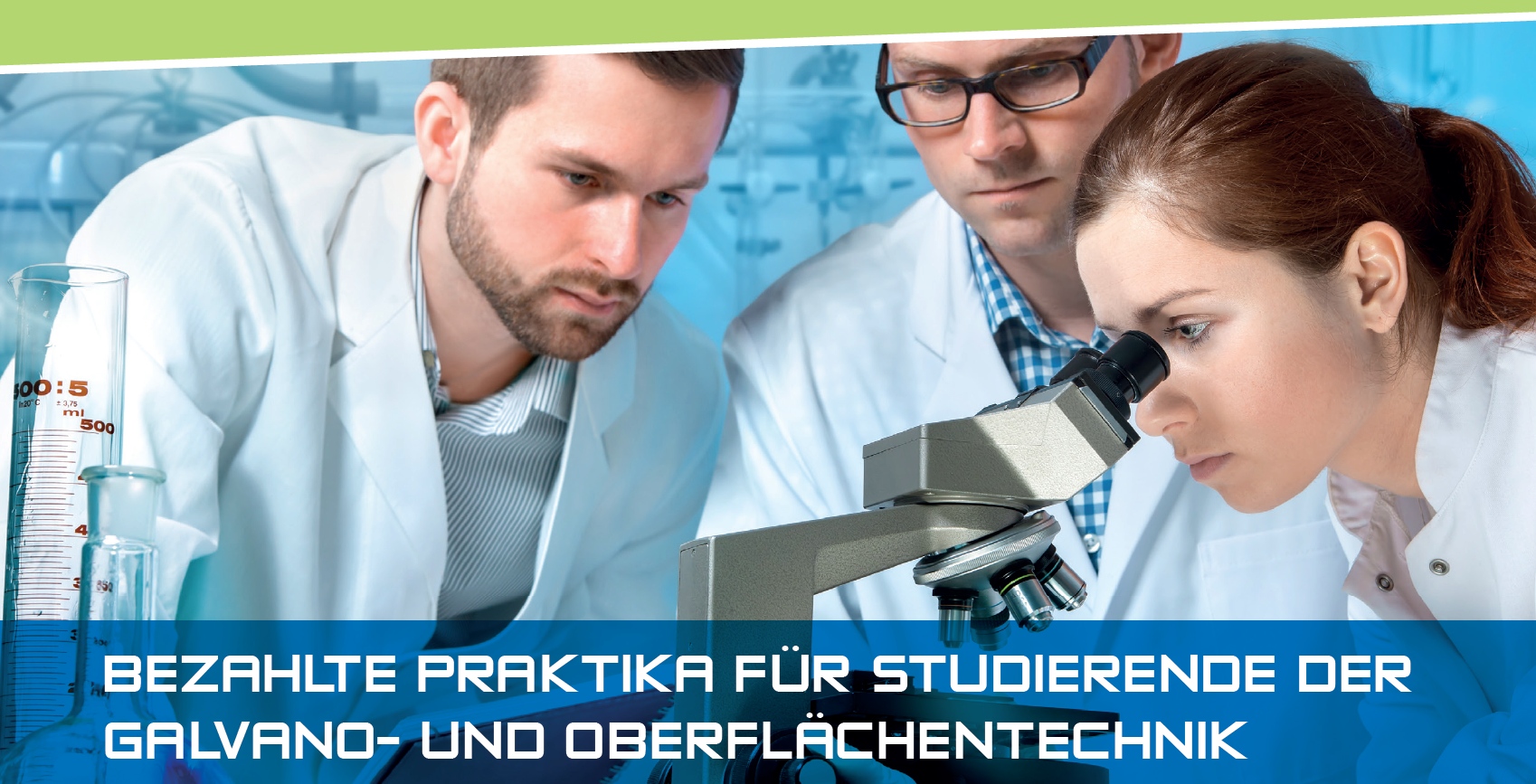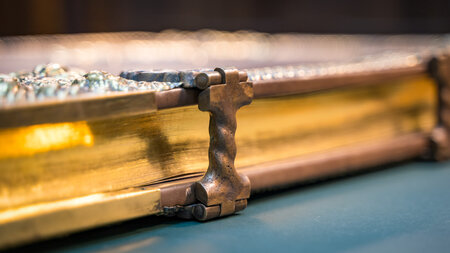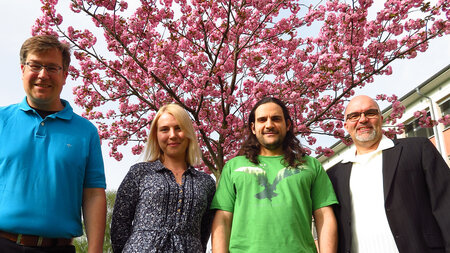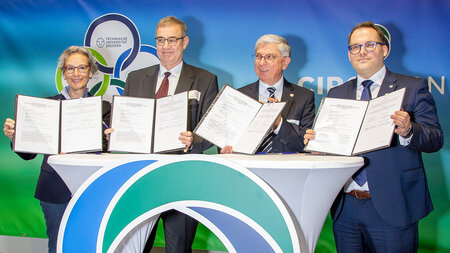Study, project and final theses
There are currently 18 student projects on offer in the following fields of work:
Passivation behaviour during plasma electrolytic oxidation (PEO) of an unalloyed steel
Due to their high strength, high modulus of elasticity, good processability and comparatively low material price, steels have a high application potential as a metallic composite partner in metal-plastic composites. The composite strength is ensured by surface treatment of the metal. In addition, unalloyed steels in particular must be protected against corrosion, as moisture can diffuse through the polymer to the metal-plastic interface. Plasma-electrolytically produced oxide layers are suitable as a corrosion barrier and enable both the chemical bonding and the mechanical interlocking of polymers. However, in the course of our own preliminary work on the PEO of an unalloyed steel in a silicate-phosphate electrolyte known from the literature, it was shown that the ignition voltage is only achieved by prescribing very high pulse current amplitudes. This results in very energy-intensive spark discharges and high energy consumption. For the production of thin, sufficiently damage-tolerant PEO layers in an energy-efficient process, improved passivation of the steel substrate is fundamentally required.
Therefore, the influence of the passivation behaviour of an unalloyed steel by adding different electrolyte components (e.g. silicate, aluminate, phosphate) and, if necessary, adjusting the pH value is investigated within the scope of the student research project with the help of model experiments in a beaker. For this purpose, complex voltage ramps are specified, which are to simulate both the voltage increase at the beginning of the process and the resistance of passive layers with decreasing process voltage, as well as repassivation if necessary. Repeatedly passing through these voltage ranges is of great importance with pulsed current conduction. The surfaces after the ramp test are also examined by means of scanning electron microscopy with regard to the properties (thickness, microstructure, chemical composition) of the surface or passive layer.
Work to be carried out:
- Literature research on the state of the art, with special attention to PEO of steels (process parameters and achievable coating properties) and anodic passivation of metals.
- Incorporation of the knowledge already available at the institute on passivation during PEO
- Carrying out coating tests at the laboratory facility of the Institute of Materials Science and Engineering
-
Planning and carrying out experimental work:
- Sampling and sample preparation
- Documentation of the experiments taking into account statistical validation
- Non-destructive determination of the layer thickness
- Light and electron microscopic examinations (incl. preparation)
- Evaluation and discussion of the results in comparison with the international literature
- Summary and conclusions and outlook
Scientific supervisor:

Plasma electrolytic oxidation of friction stir welded aluminium/steel composites
Plasma electrolytic oxidation of friction stir welded aluminium/steel compounds
Plasma electrolytic oxidation (PEO) is an innovative process for producing inorganic, often ceramic, protective and functional coatings on metallic materials. In this process, the component to be treated is switched as an alternating anode within a suitable aqueous electrolyte at high process voltages. This leads preferably within the anodic partial period of the electrical regime to the initiation of plasma-electrolytic spark discharges which, starting from the electrolyte, strike into the substrate and thereby produce a reaction layer.

Photo sequence of a PEO process (left), light microscope image of an FSW material composite (right)
In the course of the work, the PEO process is to be transferred to friction sir welding (FSW) material composites made of Al-6061 and Fe-DC04 by systematically adapting the electrolyte. This is done primarily by means of electrochemical polarisation experiments, whereby it is possible to build on already functioning test rigs and successfully completed student work.
Activities to be carried out:
- Literature research
- Familiarisation with the use of MATLAB
- Polarisation experiments on electrically coupled Al/Fe anode pairs
- Performance and evaluation of PEO tests on Al/Fr-FSW composites
- Materialographic preparation and analysis of the generated layers
Prerequisites:
- Good to very good knowledge of chemistry
- experimental skill
- Ability to work in an interdisciplinary manner
- careful and independent way of working
The call is aimed at students of engineering and natural sciences.
The announcement is aimed at students of engineering and natural science studies.
The thesis can be completed as a student research project, a bachelor thesis or a research project. The scope of work will be adapted accordingly. Due to construction constraints, the start of the practical work is not possible before December 2020. Furthermore, the course of the experimental activities depends on the constantly updated Corona requirements.
Scientific supervisor:

Influence of capacitive effects on the localisation of anodic layer formation
Anodic oxidation is a proven surface technology process for the production of corrosion-protective and wear-resistant conversion coatings on aluminium alloys. Usually, anodic oxidation is carried out in an immersion process, whereby the conversion process takes place on all surfaces of a component that are freely accessible by the electrolyte. Limiting the process to selected functional surfaces is conventionally only possible by elaborately covering all other surfaces. In previous investigations, the aim was to localise the anodic oxide formation to a small surface area using an electrolyte free jet. A major obstacle to localised layer growth is the increased flow of the electric current in the radial direction with increasing thickness of the electrically insulating oxide layer in the centre of the wetted surface. First preliminary investigations prove that short voltage pulses in the millisecond range are suitable for achieving increased localisation. It is assumed that the double layer capacitance at the electrolyte-oxide interface is first overcome in the centre under these conditions and further layer growth is initiated. The double layer capacitance increases strongly with decreasing junction thickness.
Within the scope of the present work, it is to be investigated to what extent this effect can be used to enhance the localisation of the layer formation. For this purpose, a "punctiform" cathode is placed in an electrolyte bath at a small distance from the anode (Al alloy EN AW-7075), with a large anode/cathode area ratio. With the same average anodic current density (i.e. comparable oxide formation rate), different junction thicknesses are realised by different process voltages, which can be adjusted in a wide range by varying the type and concentration of the acid anions. The localisation of the layer formation is evaluated on the basis of the layer thickness distribution on the metallographically target-prepared cross-section using light and scanning electron microscopy. In addition to the localisation experiments with wire electrode, the quantification of the double layer capacitance for the electrolytes used is carried out in a separate experimental setup during the two-dimensional anodic oxidation under direct current conditions by superimposed electrochemical impedance spectroscopy (EIS).
Work to be carried out:
- Literature research on the state of the art, with special attention to localised anodic oxidation and the electrochemical processes at the oxide-electrolyte interface during anodic oxidation.
- Incorporation of the knowledge already available at the institute on locally limited anodic oxidation and in-process EIS measurements
-
Planning and carrying out experimental work:
- Sampling and sample preparation
- locally limited anodic oxidation by means of a "point electrode" using pulse current
- EIS measurements during anodic oxidation
- Documentation of the experiments taking into account statistical validation
- Light and scanning electron microscopic examinations (incl. preparation)
- Evaluation and discussion of the results in comparison with the international literature
- Summary and conclusions and outlook
Scientific supervisor:

Pretreatment of aluminium substrates by anodic oxidation for direct printing of plastics in the additive fused filament fabrication process
Hybrid material composites made of metals and plastics are used for moving components in order to minimise the component mass. However, the production of such composites is only economically feasible for large quantities due to the high tooling costs. For small batches, the focus is therefore on additive manufacturing processes. These include the Fused Filament Fabrication (FFF) process, in which a pre-assembled metal part is printed with plastic. The boundary layer of the materials, and thus the surface pre-treatment of the metal base body, is of decisive importance for the mechanical load-bearing capacity. However, very little has been published in the technical literature in this regard to date. For example, anodic oxidation is a potentially suitable pre-treatment for aluminium components, as it structures the surface of the metal in the form of nanoscale pores, which could enable mechanical bonding of the printed plastic.
When adjusting the pore size of an anodic oxide layer, a conceptual distinction must be made between the diameter of the hexagonal pore cell and the diameter of the pore. The cell diameter increases approximately linearly with the anodising voltage, largely independent of the electrolyte composition, whereby the maximum pore diameter corresponds to the diameter of the inner circle of the hexagonal pore cell. The pore diameter at the beginning of the self-organised pore growth also tends to increase with the anodising voltage. Depending on the rate of removal by chemical re-dissolution, the pores are widened at different rates in the further course. Both the removal rate and the working range of the anodising voltage depend above all on the type and concentration of the acid as well as on the temperature. In order to adjust different cell sizes without the need for time-consuming experimental determination of suitable working ranges, anodic oxidation is carried out at moderate current density for different concentrations of sulphuric, oxalic and phosphoric acid. The process voltages required for this are expected to be between about 10 V (sulphuric acid) and 250 V (phosphoric acid). The pore expansion will be varied by different anodising durations and, if necessary, additional ageing in sulphuric acid solution. The pore and cell size is determined using high-resolution scanning electron microscopy (SEM) surface images. This knowledge base is used to produce anodic oxide layers with defined pore geometry for research into the penetration of plastics into the oxide pores during 3D printing. Due to the adjustable size and periodicity of the pores, the structured surfaces also have a model character and enable a higher-level statement about which geometric features nanoscale structures may have so that they can be infiltrated with plastic in the FFF process. In this regard, it will also be investigated how the chemism of the plastic - based on typical 3D printing plastics such as polylactic acid ester (PLA) and polyamide - and the 3D printing parameters (temperature of the nozzle and building platform, printing speed) affect the infiltration of the pores. The penetration depth of the plastic is examined on transverse sections to be evaluated by scanning electron microscopy (SEM) or atomic force microscopy (AFM).
The work includes a national and international literature review on the state of the art in science and technology with the following focal points:
- Layer formation mechanism in anodic oxidation and factors influencing structure formation
- Influence of the chemical composition of the electrolyte and the corresponding incorporation of (in)organic acid residues into the anodic oxide layer on the adhesion to various plastics
- Selection of additive manufacturing parameters and of adhesive surface treatments of the metal part on the manufacturability of metal-plastic components
The experiments include the following tasks or topics:
- Planning and carrying out the anodising experiments for surface pre-treatment
- Sample preparation and accompaniment of the layer analysis
- Plastic 3D printing on the anodically oxidised samples in the FFF process with targeted variation of the FFF manufacturing parameters.
- Characterisation of the formed bonding zone of the metal-plastic components as a function of the surface pre-treatment and the FFF manufacturing parameters by cross-sections and via adhesion peel tests with accompanying fracture surface analysis.
- Documentation, processing and evaluation of the results
The assignment is suitable for the following formats: student research project, bachelor's thesis, internship thesis, research project or similar.
.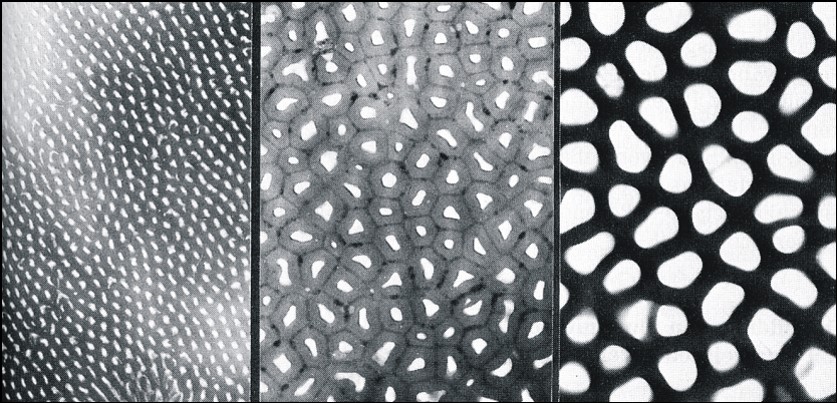
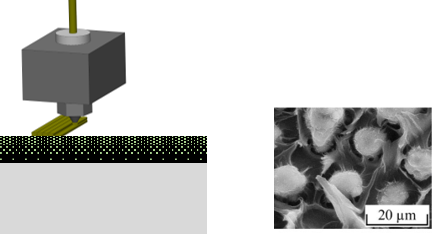
Electron microscope image of an anodic oxide layer (left) and schematics for printing plastic onto a metal using FFF (right).
Scientific supervisor:

Electrolyte and process design for chemical/galvanic deposition of REACh-compliant (cyanide-free) Au layers
Due to the outstanding chemical resistance of gold, electroplating is an established method when it comes to ensuring long-term stable electrical contacts in medium and small load ranges. The majority of electroplated fine gold deposits for microelectronics are made from cyanide baths, as these have the necessary long-term stability required for the convenient use of electrolytes in commercial applications. The need for cyanide-free gold electrolytes has existed for a long time: however, the handling of cyanides with regard to occupational safety and environmental protection is associated with high risks, and companies are thus forced to take on a considerable amount of extra bureaucracy (hazardous substance management) and protective measures (exhaust air, waste water treatment and occupational safety). Due to the release of cyanide in acidic solutions or the so-called "underplating" when using basic electrolytes, cyanide gold electrolytes have significant disadvantages.
The aim is to take a closer look at the chemical or galvanic deposition of Au layers and to carry out an electrolyte and process design. By varying the electrolyte and coating parameters, it is possible to influence the layer thickness and properties. A mechanistic analysis of the different processes during deposition will provide a deeper insight into the processes of Au deposition.

In the picture: Chemically deposited Au layer
Work to be carried out:
- Literature research on the state of research and technology
- Adjustment of a base electrolyte for the deposition of Au layers
-
Planning, carrying out and documenting experimental work
- Additivation of the electrolyte to optimise the separation conditions
- Process optimisation & improvement of the long-term stability of the electrolyte
- Layer characterisation (e.g. with regard to conductivity, wear and corrosion)
- Evaluation and discussion of the results in comparison with the international literature
Prerequisites:
- Good to very good chemical/electrochemical knowledge
- Ev. experience with surfaces and coating technology
- Experimental skill
- Ability to work in an interdisciplinary manner
- Careful and independent way of working
Scientific supervisor:

Electrolyte and process design for chemical/galvanic deposition of magnetic Fe-Co alloy layers for functionalisation of carbon fibres
Fibre-reinforced plastics are often used for the lightweight construction of highly stressed components. In many common processes for component manufacture, the problem is that the potential of the reinforcing fibres can only be partially utilised because the fibres cannot be specifically aligned with the force flow acting in the component. By galvanically coating the fibres with thin Fe-Co layers, they are supplemented with permanent magnetic functionality and can thus be aligned specifically and locally in the manufacturing process of the component. The difficulty, however, lies in a suitable coating that allows sufficiently high magnetic forces during the processing of the composites, for example in the injection moulding or pressing process, in the highly viscous polymer matrix for orientation and at the same time adheres firmly enough to the fibre.
The aim is to take a closer look at the chemical/galvanic deposition of Fe-Co alloys and to carry out an electrolyte and process design that is also suitable for the coating of C-fibres. By varying the electrolyte and coating parameters, it is possible to influence the coating composition and properties. A mechanistic analysis of the different processes during deposition will provide a deeper insight into the processes of Fe-Co alloy deposition.
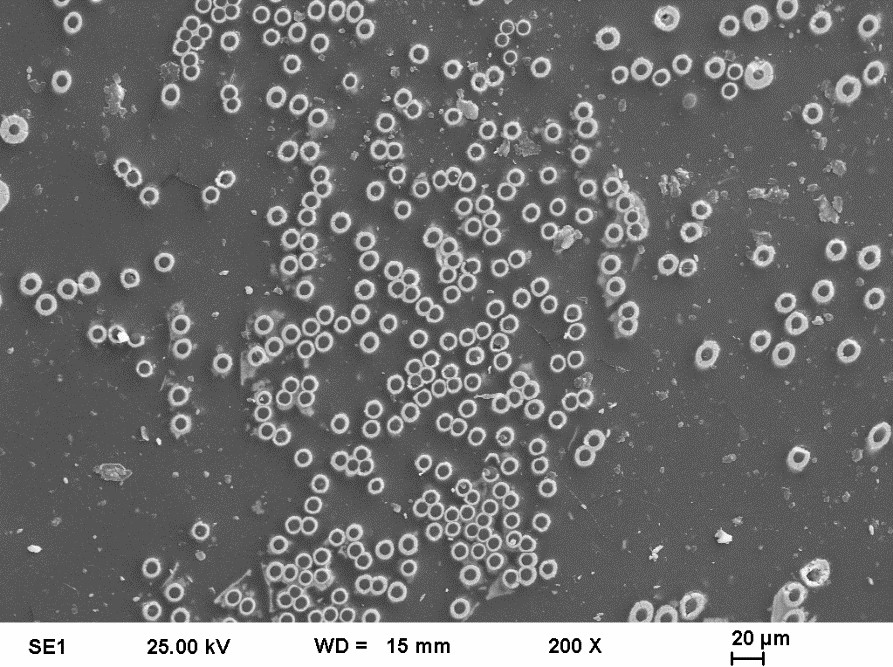
In the picture: Cross-section of electrodeposited Fe-Co alloy layers on C-fibres.
Work to be carried out:
- Literature research on the state of research and technology
- Adjustment of a basic electrolyte for the deposition of Fe-Co alloys (on different substrates)
-
Planning, carrying out and documenting experimental work
- Additivation of the electrolyte to optimise the separation conditions
- Process optimisation & improvement of the long-term stability of the electrolyte
- Layer characterisation (e.g. with regard to adhesion and ductility)
- Evaluation and discussion of the results in comparison with the international literature
Prerequisites:
- Good to very good chemical/electrochemical knowledge
- Ev. experience with surfaces and coating technology
- Experimental skill
- Ability to work in an interdisciplinary manner
- Careful and independent way of working
Scientific supervisor:
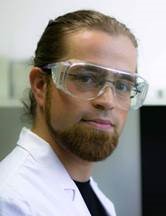
Electrolyte and process design for the electrodeposition of REACh-compliant Fe-Cr-Ni coatings
Current research focuses on the development and optimisation of technical achievements to reduce energy costs, conserve resources and increase sustainability. High-alloy steels such as 1.4301 (FeCr18Ni8) are used as a standard bulk material for applications that place high demands on corrosion and wear resistance. However, high-performance components can also be manufactured from less expensive materials and finished with thin metallic Fe-Cr-Ni coatings. These then offer the advantages of a high-alloy surface without the need to manufacture the components from expensive solid material. Galvanic application of such alloys could significantly reduce costs for applications. Furthermore, in addition to the good properties, these alloy coatings offer a potential substitution possibility for coatings that have so far been deposited from REACh-regulated Cr(VI) electrolytes and can represent an alternative to bright chrome systems.
The aim is to take a closer look at the electrodeposition of Fe-Cr-Ni alloys and to carry out an electrolyte and process design. By varying the electrolyte and coating parameters, it is possible to influence the coating composition and properties. A mechanistic analysis of the different processes during deposition will provide a deeper insight into the processes of Fe-Cr-Ni alloy deposition.
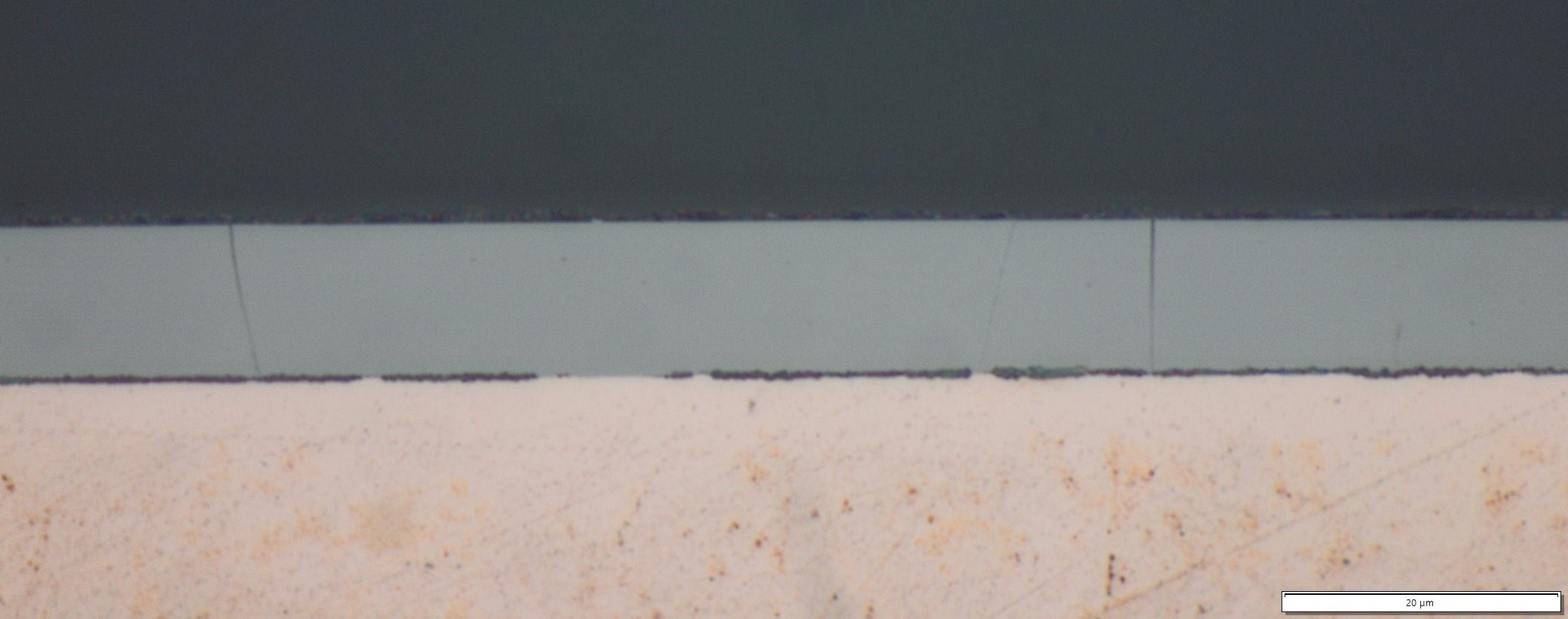
In the picture: Cross-section of an electroplated Fe-Cr-Ni alloy layer.
Work to be carried out:
- Literature research on the state of research and technology
- Adjustment of a basic electrolyte for the deposition of Fe-Cr-Ni alloys
-
Planning, carrying out and documenting experimental work
- Additivation of the electrolyte to optimise the separation conditions
- Process optimisation & improvement of the long-term stability of the electrolyte
- Layer characterisation (e.g. with regard to wear and corrosion)
- Evaluation and discussion of the results in comparison with the international literature
Prerequisites:
- Good to very good chemical/electrochemical knowledge
- Ev. experience with surfaces and coating technology
- Experimental skill
- Ability to work in an interdisciplinary manner
- Careful and independent way of working
Scientific supervisor:

Electrolyte and process design for the electrodeposition of multilayer coating systems
The aim of the work is to develop protective coatings for corrosion or wear protection that are harmless to health. This can be realised by excluding nickel for corrosion protection or by excluding electrolytes containing Cr(VI) for wear protection. The multilayer systems to be developed are several single layers of two electrochemically deposited metals layered on top of each other.
This also includes layer systems in which binary alloy layers of different compositions alternate. Electroplated deposits can be produced in different processes: On the one hand, the deposition of alternating layers can be carried out with the 2-electrolyte process (2-EL) using direct current (2-EL-DC) in several process baths or with the 1-electrolyte process (1-EL) using pulsed current or direct current deposition processes (1-EL-PC/DC) in one process bath. For corrosion protection, alternating metal layers of different electronegativity (sacrificial layer and protective layer) are deposited. For example, conventional zinc-nickel coatings (1 layer each) can be replaced by alternating zinc-based multilayers, for example zinc-iron or zinc-manganese. For wear protection, alternating nanometre-thin metal layers of different hardness are deposited. The chromium- and nickel-based multilayer coatings deposited in this way could thus replace conventional hard chromium or pure nickel dispersion coatings, for example.
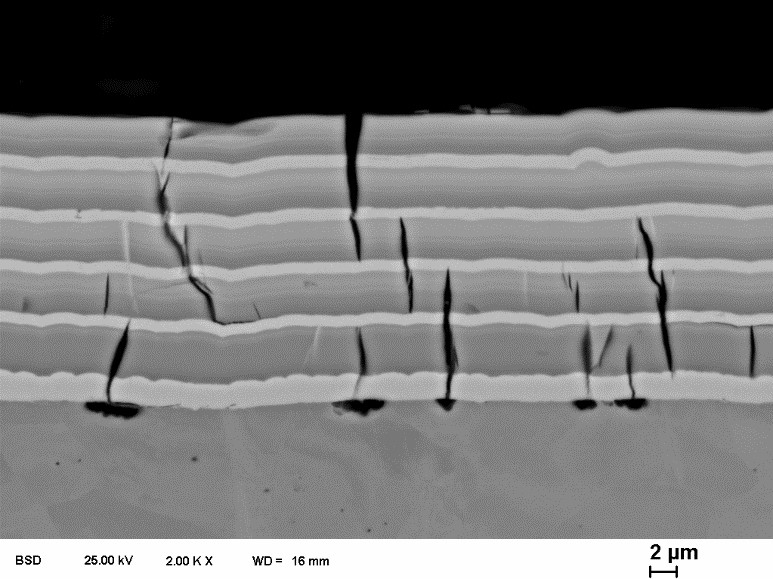
In the picture: Scanning electron microscope image of a Cr-Ni multilayer coating.
Work to be carried out:
- Literature research on the state of research and technology
- Adjustment of base electrolytes for the deposition of multilayer coatings
-
Planning, carrying out and documenting experimental work
- Additivation of the electrolyte to optimise the separation conditions
- Process optimisation & improvement of the long-term stability of the electrolyte
- Layer characterisation (e.g. with regard to wear and corrosion)
- Evaluation and discussion of the results in comparison with the international literature
Prerequisites:
- Good to very good chemical/electrochemical knowledge
- Ev. experience with surfaces and coating technology
- Experimental skill
- Ability to work in an interdisciplinary manner
- Careful and independent way of working
Scientific supervisor:

Abrasion resistance of hard-material-reinforced arc-sprayed coatings in the rubber-wheel test
The use of cored wires in the field of thermal spraying enables the production of hard material-reinforced layer systems by wire arc spraying, among other methods. Cored wires consist of a metallic sheath and a powdery filler component, which can be either metallic or ceramic. The processing properties of the individual components differ considerably in some cases, which means that the coating parameters are decisive for the respective application effect of the pseudo-alloy. Within the scope of this work, the processing properties of different cored wires with hard material filling are to be investigated in the wire arc process. In addition to the application effect of the individual components, the abrasion resistance of the resulting coating systems is to be characterised in particular. For this purpose, a detailed characterisation of selected cored wires must first be carried out in advance of a parameter study during wire arc spraying. The coating systems produced are to be characterised in detail and evaluated with regard to their abrasion resistance in the rubber wheel test. On the basis of the results, generally applicable relationships to processing conditions and the influence on wear resistance are to be derived.
Focal points of the work:
- Research on hard material-reinforced cored wires based on iron, nickel as a spray additive material
- Metallographic and chemical characterisation of selected cored wires
- Familiarisation with the plant technology and assistance with the wire arc spraying tests (LS)
- Metallographic characterisation of the layer systems
- Determination of wear resistance in the Rubber-Wheel-Test
An individual piece of work is to be submitted. The focus of the project work can be individually adapted to the status of the work or the necessary steps in consultation with the supervisor.
The thesis is to be written taking into account the working instructions for the preparation of scientific papers of the respective faculty of the Chemnitz University of Technology.
Scientific supervisor:

Infrared thermography for monitoring thermal spray processes
The surface temperature during the thermal spray process has a variety of effects on the subsequent coating properties. In addition to the increased stress on the substrate material, high surface temperatures promote the formation of residual stresses and increase the risk of cracking. There is also the risk of an increased degree of oxidation. Infrared (IR) thermography offers a possibility to determine the surface temperature in the coating process without contact. Depending on the alloy system and the surface condition, the measured value can vary due to the different IR emission. In order to quantify the potential error range and to assess layer-specific influencing variables, temperature measurements using IR thermography (Optris XI80) and thermocouples in the temperature range 0-350 °C via inductive heating are to be carried out comparatively on different alloys and layer systems within the scope of this work. High velocity flame, atmospheric plasma and wire arc sprayed coatings are to be considered in these investigations. Alloys based on iron, nickel and copper serve as coating materials.
Focal points of the work:
- Research into iron-, nickel- and copper-based coating additives that are available in both wire and powder form.
- Familiarisation with the plant technology and assistance in carrying out thermal spraying processes such as high velocity flame spraying, atmospheric plasma spraying and wire arc spraying
- Familiarisation with infrared temperature measurement and thermography
- Creation of temperature calibration curves using tactile temperature measurement systems
- Adjustment and calibration of the infrared thermography measurement data
An individual piece of work is to be submitted. The focus of the project work can be individually adapted to the status of the work or the necessary steps in consultation with the supervisor.
The thesis is to be written taking into account the working instructions for the preparation of scientific papers of the respective faculty of the Chemnitz University of Technology.
Scientific supervisor:

Characterisation of microstructural influencing variables of oxide ceramic coating systems with regard to the tribological property profile
Ceramic materials are characterised by a number of advantageous properties that qualify them for various applications in the field of surface technology. In addition to high hardness and wear resistance, chemical resistance and excellent thermal and electrical insulation are particularly characteristic. A current research focus is the development of ceramic mixed oxides for superimposed stress profiles. Thermal spraying as a coating process is particularly suitable for processing for surface functionalisation. Depending on the material system used and the coating parameters, the microstructure of the coating systems can be varied over a wide spectrum. At the same time, the phase constitution can be influenced by the thermal effect in the process.
The student work deals with the investigation of interaction relationships between microstructure characteristics and the tribological property profile. The focus is on APS sprayed coating systems made of the binary material system Al2O3-Cr2O3. Depending on the load profile, the determining wear mechanisms are to be clarified and qualitative statements derived from the microstructure.
Work to be carried out:
- Literature research: Thermally sprayed coatings for tribological applications, focus - ceramic coatings by atmospheric plasma spraying, wear investigations
- Characterisation of the layer systems with regard to hardness, porosity, microstructure, phase constitution
- Selection of suitable wear tests, if necessary appropriate sample preparation
- Carrying out and evaluating the wear tests
- Description of the wear mechanism
- Correlation between microstructure and wear behaviour
Scientific supervisor:

Investigation of the influence of metallographic microsection preparation of thermally sprayed hard metal coatings on the measured porosity and hardness
The properties and performance of thermally sprayed coatings depend largely on their microstructure. For this reason, gaining knowledge of the complex interactions between the base material, spraying process and coating microstructure is of crucial importance in the development of new coating systems.
The characteristic values of hardness and porosity play an important role in the assessment of new coating systems and are usually determined on metallographically prepared cross sections. However, depending on the preparation routine, additional defects (e.g. by tearing out individual particles / splats) can be introduced into the coating during metallographic microsection preparation. These preparation artefacts influence subsequent measurements to determine microstructural parameters.
As part of the student project, the influence of metallographic preparation routines on the determination of the important characteristic values of porosity and hardness for different coating systems is investigated:
- Hard metal coatings using high velocity oxy-fuel spraying (HVOF)
- Oxide ceramic coatings using atmospheric plasma spraying (APS)
- Ni-based coatings by means of powder flame spraying (PFS)
The following factors are considered to be important influencing variables during metallographic preparation:
- Removal location (position in relation to the movement of the spray gun)
- Cutting step (e.g. cutting disc, cutting speed, cutting angle)
- Grinding and polishing (e.g. contact pressure, grinding and polishing time, grinding and polishing steps)
To check the potential influence of the preparation, porosity and hardness measurements are carried out and compared as a function of the preparation routine. The porosity measurement is carried out with the aid of a computerised evaluation of light microscope images. The Vickers microhardness HV0.3 is measured using the indenter method according to DIN EN ISO 14923 or DIN EN ISO 6507.
Work to be carried out:
- Literature research: porosity and hardness measurements on thermally sprayed coatings, microsection preparation and possible correlations with the measurement results
- Carrying out individual preparation steps or complete preparation of cross-sections
- Preparation of light microscopic images
- Carrying out and analysing porosity and Vickers microhardness measurements
- Summarising and evaluating the results in the form of a written scientific paper
Scientific supervisor:

Influence of adiabatic shear bands on the corrosion behaviour of high-speed shear cut surfaces
Content:
Influence of adiabatic shear bands on the corrosion behaviour of high-speed shear cut surfacesCutting-free cutting processes represent the most economically significant processes and are used in almost every large-scale production of metallic components. Shear cutting comprises all non-cutting cutting processes in which, according to the DIN 8588 standard, the material is separated by two cutting edges moving past each other. In sheet metal part production, high-speed shearing (HGSS) enables the creation of extremely dimensionally accurate, low-burr cut surfaces that are characterised by low edge indentation as well as high hardness and low roughness and can thus be used directly as functional surfaces. This eliminates the need for time-consuming mechanical reworking or subsequent hardening, thus shortening the process chain and saving energy. The gating speeds of > 0.8 m/s present in the HGSS can lead to the formation of adiabatic shear bands (ASB) depending on the process and material. These are localised, strongly sheared material areas that form at high deformation speeds, clearly separate themselves microstructurally from the base material and exhibit high hardness and resistance to etching attacks. A comprehensive consideration of the corrosion properties of adiabatic shear bands has not yet been given in the scientific literature. Therefore, the aim of this work is to work out the correlations between the HGSS process parameters, the resulting microstructure of the material and the corrosion behaviour. For this purpose, micro- and macro-scale corrosion tests and microstructural analysis are carried out comparatively for normal and high-speed shear cut as well as untreated reference samples of the steel 22MnB5.
Work to be carried out:
-
Literature research on the state of the art in science and technology with a focus on:
- High-speed cutting processes (HGSS) and influencing the microstructure
- Corrosion mechanisms and influences on corrosion behaviour
-
Planning, carrying out and documenting experimental work
- Macro (immersion and salt spray test, rest potential measurements) and micro corrosion tests (micro corrosion cell) to determine the corrosion tendency, form and rate
- Microstructural characterisation by means of light and scanning electron microscopy to characterise the microstructure and corrosive ablation
- Surface analysis by means of laser scanning microscopy
- Microhardness measurements
- Evaluation and discussion of the results and possible mechanisms and influencing factors in comparison to the international literature.
The topic is suitable as a Bachelor's or Master's thesis or for comparable student work. Students are expected to work independently and responsibly. In addition, a good knowledge of English is required, as the majority of the specialist literature to be researched is written in English. The results of the research are to be documented, taking into account statistical evaluation possibilities. Deviations from the assignment are to be made in consultation with the supervisor.
Scientific supervisor:
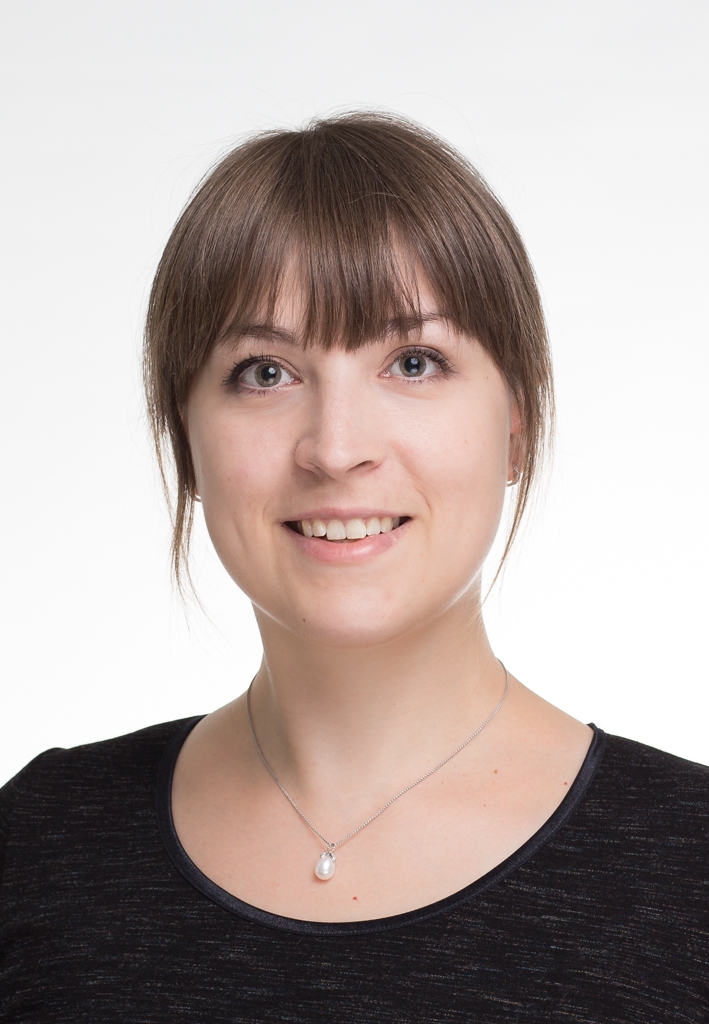
Electrolyte and process design for the production of cadmium-free hard gold coatings (external)
Gold coatings are characterised by their excellent corrosion resistance and their good electrical properties. These two properties result in the application in electrical contact components, such as connectors, contacts for relays or switches. In its pure form, however, gold is very soft and so thin gold layers are quickly worn through. Therefore, hard gold layers are used in sliding contacts in which the ternary system gold-copper-cadmium is preferably used. Due to the RoHS regulation for electrical contacts, the industrial use of cadmium will no longer be permitted from July 2024 and appropriate alternatives are being sought.
The aim of the project is to develop a hard gold electrolyte that deposits tough-hard gold alloys with high wear resistance in high layer thicknesses > 10 μm. A low contact resistance and high corrosion resistance are also to be realised.

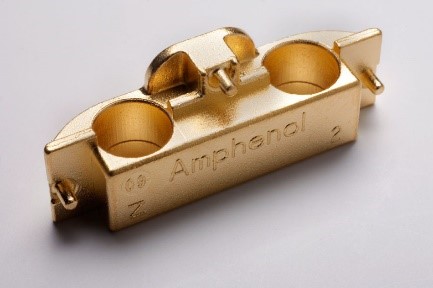
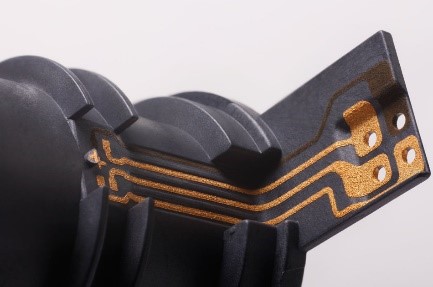
For this purpose, in cooperation with Collini AG ( www.collini.eu ), an internationally active company in surface coating, offered a student research project. The work is done with direct application in practice at the Collini site in the immediate vicinity of the city of Zurich in Switzerland. Collini AG will contribute financially to the additional living costs incurred during a work assignment in Switzerland.
Work to be carried out:
- Literature research on the state of research and technology
- Adjustment of a basic electrolyte for the deposition of hard gold alloys
-
Planning, carrying out and documenting experimental work
- Addtivation of the electrolyte to optimise the separation conditions
- Layer characterisation with regard to wear and contact resistance
- Process optimisation & improvement of the long-term stability of the electrolyte
- Evaluation and discussion of the results in comparison with the international literature
Prerequisites:
- good to very good knowledge of chemical and electrochemical coating technology
- experimental skill
- Ability to work in an interdisciplinary manner
- careful and independent way of working
- Willingness to work abroad (Switzerland)
Scientific supervisor:

Synthesis of plasma electrolytic coatings on ferrous materials for biomedical and industrial applications
MEOTEC is an innovative Aachen-based research company specialising in the electrochemical and plasma electrolytic surface modification (ceramisation) of light metals and active in the field of medical device technology.
In anodic oxidation, constant parameters (e.g. current intensity or current density) are traditionally used during the process. This procedure contains a contradiction in that the constant regime is contrasted with a non-constant, constantly changing material surface.
In the course of the work, suitable electrolytes and parameters are to be researched in order to be able to fundamentally evaluate the potential of plasma electrolytic oxidation (PEO) of iron-based materials for applications in medical technology and industrial areas such as automotive engineering or aviation. The basic prerequisite is to prove the feasibility of technically closed and mechanically resilient iron oxide coatings using PEO. These could be used, for example, as degradation-influencing layers for degradable iron-based implants or as a thermal barrier (TBC) and wear protection for applications in engine construction, e.g. in the refinement of the piston crown. The aim of the work is therefore to collect a comprehensive status of the research activities published to date and to derive suitable parameter ranges for researching and optimising PEO coatings on iron materials.

Development of the discharge behaviour during PEO of Al
Activities to be carried out:
- Literature research
- Statistical Design of Experiments (DoE)
- Sample production (electrolytes, coatings)
- Materialographic preparation and analysis of the generated layers
- Evaluation of the experiments and deduction of stratification mechanisms
Prerequisites:
- Good to very good knowledge of chemistry
- experimental skill
- Ability to work in an interdisciplinary manner
- careful and independent way of working
The call for applications is aimed at students in the field of Medical Engineering
Application with proof of previous academic achievements to:
Dr Alexander Kopp
Alexander.Kopp@meotec.eu
Phillipsstraße 8, 52068 Aachen
Scientific supervisor:

Combination cone roller for RAW 333
As part of the GMH Group, Schmiedewerke Gröditz operates a radial-axial rolling mill (RAW330/260-4500/650) at its site.
Here, seamless rolled rings, wheel tyres and flanges are produced up to a unit weight of 4,000kg and an outer diameter of 4,000mm.
In the course of a planned modernisation measure, we are inviting tenders for a diploma thesis or student research project in the field of mechanical engineering/design for the following project.
Problem description:
High production costs and set-up times due to changing the taper rollers on the RAW H330/ V260- 4500/ 650. After reaching the wear limit (a few millimetres), 2 taper rollers (approx. 2t each) must be completely removed and reconditioned.
Objective:
Review of the technical and economic feasibility of dividing the tapered rollers into a base body (non-changeable) and a working body (wear part, changeable).
- Development of concept proposals
- Investigation of manufacturing possibilities
- Process engineering design and checking the design for load safety
- Selection of the preferred variant on the basis of the technical and economic framework conditions
- Calculation of the amortisation period
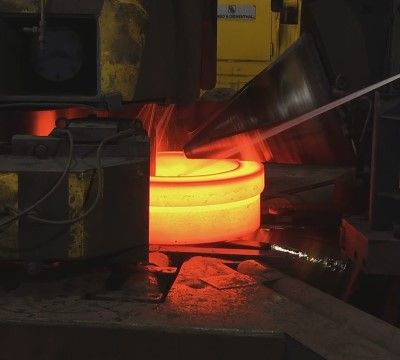
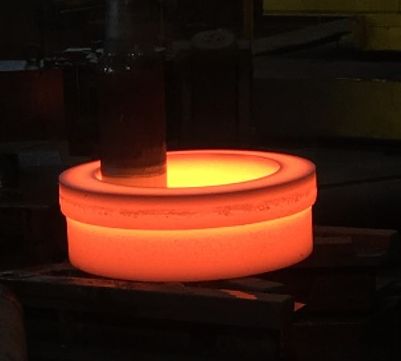
Industry partners:
Weddin, Christopher
CIP representative ring rolling mill
Phone: +49 35 26362 - 404
Mobile: +49 151 61558952
Christopher.Weddin@gmh-gruppe.de www.stahl-groeditz.de
Karasevich, Igor
Development Engineer
Work preparation ring rolling mill
Phone: +49 35 26362 - 666
Mobile: +49 172 3602238
Igor.Karasevich@gmh-gruppe.de www.stahl-groeditz.de
Scientific supervisor:

Roller table adjustment for RAW 333
As part of the GMH Group, Schmiedewerke Gröditz operates a radial-axial rolling mill (RAW330/260-4500/650) at its site.
Here, seamless rolled rings, wheel tyres and flanges are produced up to a unit weight of 4,000kg and an outer diameter of 4,000mm.
In the course of a planned modernisation measure, we are inviting tenders for a diploma thesis or student research project in the field of mechanical engineering/design for the following project.
Problem description:
No automated adjustment of the roller tables on the RAW H330/ V260- 4500/ 650, which up to now has had to be adjusted manually each week using an impact wrench.No automated adjustment of the roller tables on the RAW H330/ V260- 4500/ 650, which up to now has had to be adjusted manually each week using an impact wrench.
Objective:
Review of the technical and economic feasibility of an automated roll table adjustment at the RAW H330/ V260- 4500/ 650.
- Analysis of existing system Roller table adjustment on RAW H160/ V100
- Review of the technical framework conditions at RAW H330/ V260
- Preparation of the concept proposals
- Selection of the preferred variant on the basis of the technical and economic framework conditions
- Calculation of the amortisation period


Industry partners:
Weddin, Christopher
CIP representative ring rolling mill
Phone: +49 35 26362 - 404
Mobile: +49 151 61558952
Christopher.Weddin@gmh-gruppe.de www.stahl-groeditz.de
Karasevich, Igor
Development Engineer
Work preparation ring rolling mill
Phone: +49 35 26362 - 666
Mobile: +49 172 3602238
Igor.Karasevich@gmh-gruppe.de www.stahl-groeditz.de
Scientific supervisor:

Topics for internships and theses Schmiedewerke Gröditz
Adaptation of the existing model for the calculation of the rolling forces during rolling
Adaption of the consisting calculation model of rolling forces
Creation of a catalogue of defects and measures for the ring-rolled products and forming tools
Generation of a catalogue of defects and measures for ring rolling products and forming tools
Immersion time calculation depending on the furnace occupancy and the material for the quenching and tempering process
Generation of a calculation model of quenching time in dependence on furnace occupancy and steel grade
Industry partners:
Weddin, Christopher
CIP representative ring rolling mill
Phone: +49 35 26362 - 404
Mobile: +49 151 61558952
Christopher.Weddin@gmh-gruppe.de www.stahl-groeditz.de
Karasevich, Igor
Development Engineer
Work preparation ring rolling mill
Phone: +49 35 26362 - 666
Mobile: +49 172 3602238
Igor.Karasevich@gmh-gruppe.de www.stahl-groeditz.de
Scientific supervisor:



